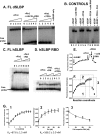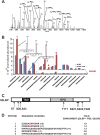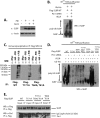The prolyl isomerase Pin1 targets stem-loop binding protein (SLBP) to dissociate the SLBP-histone mRNA complex linking histone mRNA decay with SLBP ubiquitination
- PMID: 22907757
- PMCID: PMC3486140
- DOI: 10.1128/MCB.00382-12
The prolyl isomerase Pin1 targets stem-loop binding protein (SLBP) to dissociate the SLBP-histone mRNA complex linking histone mRNA decay with SLBP ubiquitination
Abstract
Histone mRNAs are rapidly degraded at the end of S phase, and a 26-nucleotide stem-loop in the 3' untranslated region is a key determinant of histone mRNA stability. This sequence is the binding site for stem-loop binding protein (SLBP), which helps to recruit components of the RNA degradation machinery to the histone mRNA 3' end. SLBP is the only protein whose expression is cell cycle regulated during S phase and whose degradation is temporally correlated with histone mRNA degradation. Here we report that chemical inhibition of the prolyl isomerase Pin1 or downregulation of Pin1 by small interfering RNA (siRNA) increases the mRNA stability of all five core histone mRNAs and the stability of SLBP. Pin1 regulates SLBP polyubiquitination via the Ser20/Ser23 phosphodegron in the N terminus. siRNA knockdown of Pin1 results in accumulation of SLBP in the nucleus. We show that Pin1 can act along with protein phosphatase 2A (PP2A) in vitro to dephosphorylate a phosphothreonine in a conserved TPNK sequence in the SLBP RNA binding domain, thereby dissociating SLBP from the histone mRNA hairpin. Our data suggest that Pin1 and PP2A act to coordinate the degradation of SLBP by the ubiquitin proteasome system and the exosome-mediated degradation of the histone mRNA by regulating complex dissociation.
Figures








Similar articles
-
The prolyl isomerase pin1 regulates mRNA levels of genes with short half-lives by targeting specific RNA binding proteins.PLoS One. 2014 Jan 9;9(1):e85427. doi: 10.1371/journal.pone.0085427. eCollection 2014. PLoS One. 2014. PMID: 24416409 Free PMC article.
-
Phosphorylation of stem-loop binding protein (SLBP) on two threonines triggers degradation of SLBP, the sole cell cycle-regulated factor required for regulation of histone mRNA processing, at the end of S phase.Mol Cell Biol. 2003 Mar;23(5):1590-601. doi: 10.1128/MCB.23.5.1590-1601.2003. Mol Cell Biol. 2003. PMID: 12588979 Free PMC article.
-
Knockdown of SLBP results in nuclear retention of histone mRNA.RNA. 2009 Mar;15(3):459-72. doi: 10.1261/rna.1205409. Epub 2009 Jan 20. RNA. 2009. PMID: 19155325 Free PMC article.
-
Formation of the 3' end of histone mRNA.Gene. 1999 Oct 18;239(1):1-14. doi: 10.1016/s0378-1119(99)00367-4. Gene. 1999. PMID: 10571029 Review.
-
Stem-loop binding protein and metal carcinogenesis.Semin Cancer Biol. 2021 Nov;76:38-44. doi: 10.1016/j.semcancer.2021.08.006. Epub 2021 Aug 18. Semin Cancer Biol. 2021. PMID: 34416372 Free PMC article. Review.
Cited by
-
O-Glycosylation of a Secretory Granule Membrane Enzyme Is Essential for Its Endocytic Trafficking.J Biol Chem. 2016 Apr 29;291(18):9835-50. doi: 10.1074/jbc.M115.711838. Epub 2016 Mar 9. J Biol Chem. 2016. PMID: 26961877 Free PMC article.
-
Intranuclear and higher-order chromatin organization of the major histone gene cluster in breast cancer.J Cell Physiol. 2018 Feb;233(2):1278-1290. doi: 10.1002/jcp.25996. Epub 2017 Jun 22. J Cell Physiol. 2018. PMID: 28504305 Free PMC article.
-
Mycobacterium tuberculosis universal stress protein Rv2623 interacts with the putative ATP binding cassette (ABC) transporter Rv1747 to regulate mycobacterial growth.PLoS Pathog. 2017 Jul 28;13(7):e1006515. doi: 10.1371/journal.ppat.1006515. eCollection 2017 Jul. PLoS Pathog. 2017. PMID: 28753640 Free PMC article.
-
The prolyl isomerase pin1 regulates mRNA levels of genes with short half-lives by targeting specific RNA binding proteins.PLoS One. 2014 Jan 9;9(1):e85427. doi: 10.1371/journal.pone.0085427. eCollection 2014. PLoS One. 2014. PMID: 24416409 Free PMC article.
-
Single-nucleus and spatial transcriptome reveal adrenal homeostasis in normal and tumoural adrenal glands.Clin Transl Med. 2024 Aug;14(8):e1798. doi: 10.1002/ctm2.1798. Clin Transl Med. 2024. PMID: 39167619 Free PMC article.
References
-
- Albert A, Lavoie S, Vincent M. 1999. A hyperphosphorylated form of RNA polymerase II is the major interphase antigen of the phosphoprotein antibody MPM-2 and interacts with the peptidyl-prolyl isomerase Pin1. J. Cell Sci. 112(Part 15):2493–2500 - PubMed
-
- Dimitrova DS, Berezney R. 2002. The spatio-temporal organization of DNA replication sites is identical in primary, immortalized and transformed mammalian cells. J. Cell Sci. 115:4037–4051 - PubMed
Publication types
MeSH terms
Substances
Grants and funding
LinkOut - more resources
Full Text Sources
Molecular Biology Databases
Miscellaneous
